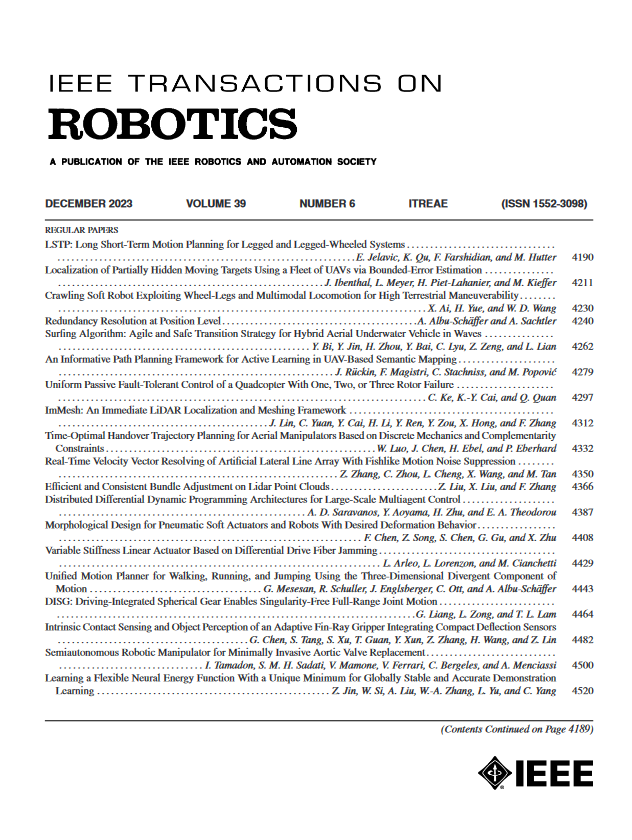MAGICVFM-Meta-Learning Adaptation for Ground Interaction Control With Visual Foundation Models
IF 9.4
1区 计算机科学
Q1 ROBOTICS
引用次数: 0
Abstract
Control of off-road vehicles is challenging due to the complex dynamic interactions with the terrain. Accurate modeling of these interactions is important to optimize driving performance, but the relevant physical phenomena, such as slip, are too complex to model from first principles. Therefore, we present an offline meta-learning algorithm to construct a rapidly-tunable model of residual dynamics and disturbances. Our model processes terrain images into features using a visual foundation model (VFM), then maps these features and the vehicle state to an estimate of the current actuation matrix using a deep neural network (DNN). We then combine this model with composite adaptive control to modify the last layer of the DNN in real time, accounting for the remaining terrain interactions not captured during offline training. We provide mathematical guarantees of stability and robustness for our controller, and demonstrate the effectiveness of our method through simulations and hardware experiments with a tracked vehicle and a car-like robot. We evaluate our method outdoors on different slopes with varying slippage and actuator degradation disturbances, and compare against an adaptive controller that does not use the VFM terrain features. We show significant improvement over the baseline in both hardware experimentation and simulation.MAGICVFM - 利用可视地基模型进行地面交互控制的元学习适配
由于越野车辆与地形复杂的动态相互作用,其控制具有挑战性。这些相互作用的准确建模对于优化驾驶性能非常重要,但相关的物理现象,如滑移,太复杂,无法从第一性原理建模。因此,我们提出了一种离线元学习算法来构建一个快速可调的剩余动态和干扰模型。我们的模型使用视觉基础模型(VFM)将地形图像处理成特征,然后使用深度神经网络(DNN)将这些特征和车辆状态映射到当前驱动矩阵的估计。然后,我们将该模型与复合自适应控制相结合,实时修改DNN的最后一层,考虑到离线训练期间未捕获的剩余地形相互作用。我们为控制器的稳定性和鲁棒性提供了数学保证,并通过履带式车辆和类车机器人的仿真和硬件实验证明了我们方法的有效性。我们在不同的斜坡上评估了我们的方法,并与不使用VFM地形特征的自适应控制器进行了比较。我们在硬件实验和仿真中都显示了比基线的显著改进。
本文章由计算机程序翻译,如有差异,请以英文原文为准。
求助全文
约1分钟内获得全文
求助全文
来源期刊

IEEE Transactions on Robotics
工程技术-机器人学
CiteScore
14.90
自引率
5.10%
发文量
259
审稿时长
6.0 months
期刊介绍:
The IEEE Transactions on Robotics (T-RO) is dedicated to publishing fundamental papers covering all facets of robotics, drawing on interdisciplinary approaches from computer science, control systems, electrical engineering, mathematics, mechanical engineering, and beyond. From industrial applications to service and personal assistants, surgical operations to space, underwater, and remote exploration, robots and intelligent machines play pivotal roles across various domains, including entertainment, safety, search and rescue, military applications, agriculture, and intelligent vehicles.
Special emphasis is placed on intelligent machines and systems designed for unstructured environments, where a significant portion of the environment remains unknown and beyond direct sensing or control.
 求助内容:
求助内容: 应助结果提醒方式:
应助结果提醒方式:


